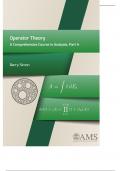Operator Theory
A Comprehensive Course in Analysis, Part 4
Barry Simon
,Operator Theory
A Comprehensive Course in Analysis, Part 4
,
, http://dx.doi.org/10.1090/simon/004
Operator Theory
A Comprehensive Course in Analysis, Part 4
Barry Simon
Providence, Rhode Island
, 2010 Mathematics Subject Classification. Primary 47-01, 34-01, 46-01;
Secondary 81Q10, 34L05, 35P05, 42C05, 46H05, 22B05.
For additional information and updates on this book, visit
www.ams.org/bookpages/simon
Library of Congress Cataloging-in-Publication Data
Simon, Barry, 1946–
Operator theory / Barry Simon.
pages cm. — (A comprehensive course in analysis ; part 4)
Includes bibliographical references and indexes.
ISBN 978-1-4704-1103-9 (alk. paper)
1. Mathematical analysis—Textbooks. 2. Operator theory. I. Title.
QA300.S5285 2015
515�.724—dc23
2015033104
Copying and reprinting. Individual readers of this publication, and nonprofit libraries
acting for them, are permitted to make fair use of the material, such as to copy select pages for
use in teaching or research. Permission is granted to quote brief passages from this publication in
reviews, provided the customary acknowledgment of the source is given.
Republication, systematic copying, or multiple reproduction of any material in this publication
is permitted only under license from the American Mathematical Society. Permissions to reuse
portions of AMS publication content are handled by Copyright Clearance Center’s RightsLink�
service. For more information, please visit: http://www.ams.org/rightslink.
Send requests for translation rights and licensed reprints to reprint-permission@ams.org.
Excluded from these provisions is material for which the author holds copyright. In such cases,
requests for permission to reuse or reprint material should be addressed directly to the author(s).
Copyright ownership is indicated on the copyright page, or on the lower right-hand corner of the
first page of each article within proceedings volumes.
�
c 2015 by the American Mathematical Society. All rights reserved.
The American Mathematical Society retains all rights
except those granted to the United States Government.
Printed in the United States of America.
�
∞ The paper used in this book is acid-free and falls within the guidelines
established to ensure permanence and durability.
Visit the AMS home page at http://www.ams.org/
10 9 8 7 6 5 4 3 2 1 20 19 18 17 16 15
, To the memory of Cherie Galvez
extraordinary secretary, talented helper, caring person
and to the memory of my mentors,
Ed Nelson (1932-2014) and Arthur Wightman (1922-2013)
who not only taught me Mathematics
but taught me how to be a mathematician
,
,Contents
Preface to the Series xi
Preface to Part 4 xvii
Chapter 1. Preliminaries 1
§1.1. Notation and Terminology 1
§1.2. Some Complex Analysis 3
§1.3. Some Linear Algebra 6
§1.4. Finite-Dimensional Eigenvalue Perturbation Theory 21
§1.5. Some Results from Real Analysis 28
Chapter 2. Operator Basics 33
§2.1. Topologies and Special Classes of Operators 34
§2.2. The Spectrum 46
§2.3. The Analytic Functional Calculus 58
§2.4. The Square Root Lemma and the Polar Decomposition 71
Chapter 3. Compact Operators, Mainly on a Hilbert Space 89
§3.1. Compact Operator Basics 91
§3.2. The Hilbert–Schmidt Theorem 102
§3.3. The Riesz–Schauder Theorem 111
§3.4. Ringrose Structure Theorems 120
§3.5. Singular Values and the Canonical Decomposition 132
§3.6. The Trace and Trace Class 136
§3.7. Bonus Section: Trace Ideals 145
vii
,viii Contents
§3.8. Hilbert–Schmidt Operators 154
§3.9. Schur Bases and the Schur–Lalesco–Weyl Inequality 161
§3.10. Determinants and Fredholm Theory 164
§3.11. Operators with Continuous Integral Kernels 174
§3.12. Lidskii’s Theorem 184
§3.13. Bonus Section: Regularized Determinants 187
§3.14. Bonus Section: Weyl’s Invariance Theorem 192
§3.15. Bonus Section: Fredholm Operators and Their Index 201
§3.16. Bonus Section: M. Riesz’s Criterion 223
Chapter 4. Orthogonal Polynomials 229
§4.1. Orthogonal Polynomials on the Real Line and Favard’s
Theorem 231
§4.2. The Bochner–Brenke Theorem 242
§4.3. L2 - and L∞ -Variational Principles: Chebyshev
Polynomials 256
§4.4. Orthogonal Polynomials on the Unit Circle: Verblunsky’s
and Szegő’s Theorems 268
Chapter 5. The Spectral Theorem 287
§5.1. Three Versions of the Spectral Theorem: Resolutions
of the Identity, the Functional Calculus, and Spectral
Measures 289
§5.2. Cyclic Vectors 301
§5.3. A Proof of the Spectral Theorem 301
§5.4. Bonus Section: Multiplicity Theory 303
§5.5. Bonus Section: The Spectral Theorem for Unitary
Operators 316
§5.6. Commuting Self-adjoint and Normal Operators 323
§5.7. Bonus Section: Other Proofs of the Spectral Theorem 328
§5.8. Rank-One Perturbations 333
§5.9. Trace Class and Hilbert–Schmidt Perturbations 345
Chapter 6. Banach Algebras 355
§6.1. Banach Algebra: Basics and Examples 357
§6.2. The Gel’fand Spectrum and Gel’fand Transform 370
§6.3. Symmetric Involutions 392
§6.4. Commutative Gel’fand–Naimark Theorem and the
Spectral Theorem for Bounded Normal Operators 400
, Contents ix
§6.5. Compactifications 407
§6.6. Almost Periodic Functions 413
§6.7. The GNS Construction and the Noncommutative
Gel’fand–Naimark Theorem 421
§6.8. Bonus Section: Representations of Locally Compact
Groups 430
§6.9. Bonus Section: Fourier Analysis on LCA Groups 448
§6.10. Bonus Section: Introduction to Function Algebras 469
§6.11. Bonus Section: The L1 (R) Wiener and Ingham Tauberian
Theorems 493
§6.12. The Prime Number Theorem via Tauberian Theorems 510
Chapter 7. Bonus Chapter: Unbounded Self-adjoint Operators 515
§7.1. Basic Definitions and the Fundamental Criterion for
Self-adjointness 518
§7.2. The Spectral Theorem for Unbounded Operators 541
§7.3. Stone’s Theorem 549
§7.4. von Neumann’s Theory of Self-adjoint Extensions 554
§7.5. Quadratic Form Methods 572
§7.6. Pointwise Positivity and Semigroup Methods 610
§7.7. Self-adjointness and the Moment Problem 633
§7.8. Compact, Rank-One and Trace Class Perturbations 660
§7.9. The Birman–Schwinger Principle 668
Bibliography 687
Symbol Index 727
Subject Index 729
Author Index 741
Index of Capsule Biographies 749




